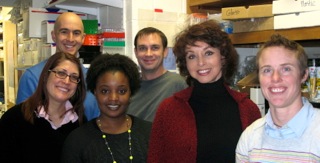Fetal Toxicology (Birth Defects) Research Team
[Left to right] Lorinda Baker, Eric Fish, Ph.D., Marcoita Gilbert, Ph.D., Scott Parnell, Ph.D., Kathy Sulik, Ph.D., Lindsay Wieczorek, Ph.D.
About the Fetal Toxicology (Birth Defects) Research Team
The work of the Fetal Toxicology research team is directed toward achieving a better understanding of the mechanisms, pathogenesis, and spectrum of dysmorphology that results from prenatal ethanol exposure.
Research Contributions
–Discovered that high doses of ethanol administered to pregnant mice, the equivalent to binge drinking during the third week in human pregnancy, results in craniofacial and CNS abnormalities that parallel those reported in babies with Fetal Alcohol Syndrome. This has helped to establish that very early stages of prenatal development are vulnerable to ethanol insult. The pictures below show the similarities between a mouse and a child’s facial abnormalities caused by drinking while pregnant compared to a mouse with normally developed facial features.

A child with FAS (a) shares the typical craniofacial features, including microcephaly, short palpebral fissures, a small nose, and long (from nose to mouth) upper lip with a deficient philtrum, with a mouse fetus whose mother was treated with alcohol on her seventh day of pregnancy (b). Illustrated for comparison is a normal mouse fetus of the same developmental stage (c).
–Identified the developmental stage-dependent patterns of ethanol-induced excessive apoptosis that follow ethanol insult during embryogenesis.
–Found that antioxidants, as well as ADNF and ADNP-derived peptides can diminish ethanol’s teratogenic effects in vitro and in vivo.
–Applied high resolution MRI as a comprehensive approach for discovery of ethanol-induced CNS and craniofacial dysmorphology

